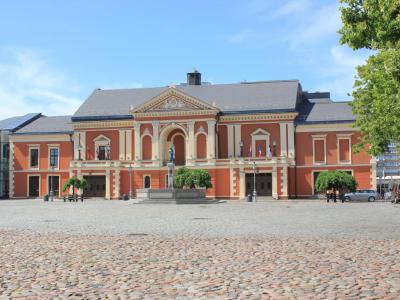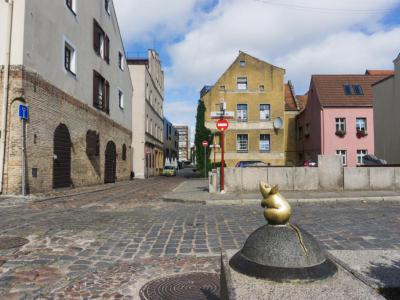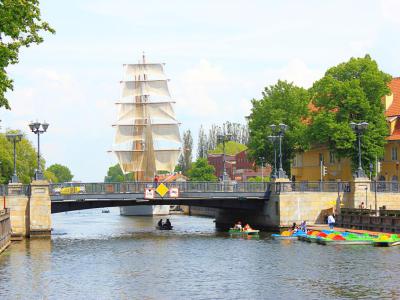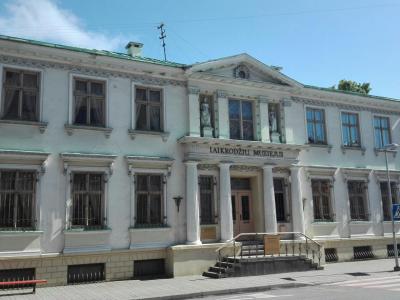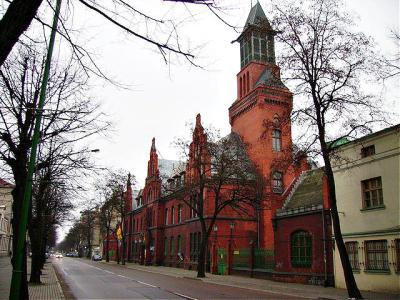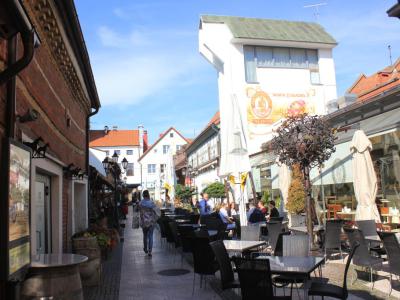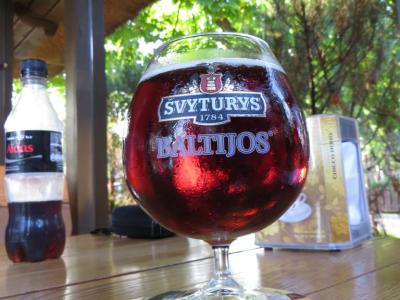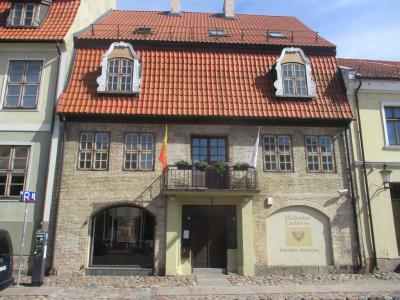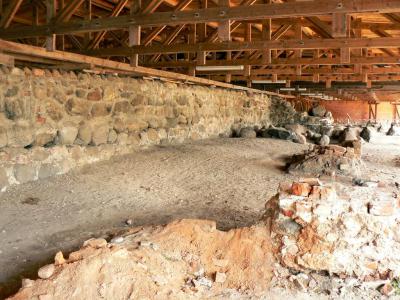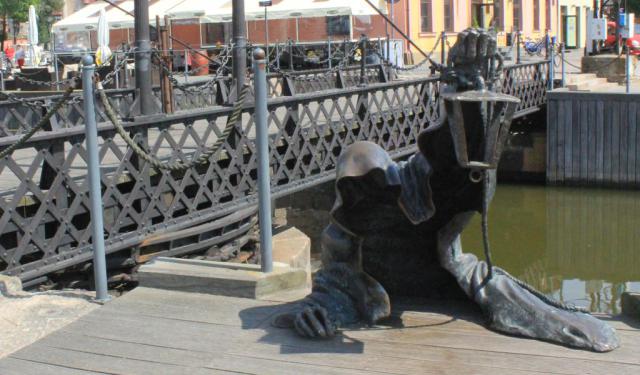Klaipeda Introduction Walking Tour (Self Guided), Klaipeda
Welcome to Klaipeda, a captivating city on the Baltic Sea coast of Lithuania! Despite being the country's third-largest city, Klaipeda often escapes the attention of tourists who might only stop by briefly before heading straight to the sea and sand dunes of the Curonian Spit.
The city has a complex history, partially due to the strategic importance of its ice-free port at the mouth of the river Akmena-Danė. Throughout the centuries, it was a part of Baltic Prussia, the Prussian State of the Teutonic Order (who called it Memel – the name used officially from 1252 to 1945), and later the Duchy of Prussia under the suzerainty of the Polish–Lithuanian Commonwealth until the duchy gained independence in 1657. As part of the Kingdom of Prussia, it was the northernmost major city in Germany up until 1919.
In 1923, the city was annexed by Lithuania only to be retaken by Germany in 1939. After World War II, the USSR captured both North East Prussia and Lithuania, incorporating the city into the Lithuanian Soviet Socialist Republic.
The Lithuanian name Klaipeda, potentially of Curonian origin, likely derives from the words "klais” or “klait" meaning flat or open, and "peda" meaning ground – a reference to the even ground of the town.
During the Soviet period, the city became a vital port with a rapidly growing population. The cultural revival began in the 1970s led to vibrant festivities and eventually turned Klaipeda into a thriving, multicultural hub and a burgeoning cruise destination.
Unlike many port cities, Klaipeda has none of the industrial facilities or dodgy vibes commonly associated with places like this. On the contrary, the riverside promenade, relaxed atmosphere, and delightful architecture in the old town make it a remarkable destination that truly deserves thorough exploration.
Begin your journey at Theater Square, a dynamic cultural spot, and move on to discover the whimsical Sculpture The Magic Mouse (Skulptur Stebuklingas Peliukas), a beloved symbol of the city's artistic spirit. Then cross the picturesque Exchange Bridge (Birzos Tiltas), offering panoramic views of the bustling harbor below. Also, a good idea is to lose yourself in the enchanting Friedrich Passage (Friedricho Pasazas), a charming enclave of shops and cafes nestled amid historic buildings.
Ultimately, whenever you have the chance, come and immerse yourself in the allure of this Lithuanian coastal gem. The memories of Klaipeda may last you a lifetime!
The city has a complex history, partially due to the strategic importance of its ice-free port at the mouth of the river Akmena-Danė. Throughout the centuries, it was a part of Baltic Prussia, the Prussian State of the Teutonic Order (who called it Memel – the name used officially from 1252 to 1945), and later the Duchy of Prussia under the suzerainty of the Polish–Lithuanian Commonwealth until the duchy gained independence in 1657. As part of the Kingdom of Prussia, it was the northernmost major city in Germany up until 1919.
In 1923, the city was annexed by Lithuania only to be retaken by Germany in 1939. After World War II, the USSR captured both North East Prussia and Lithuania, incorporating the city into the Lithuanian Soviet Socialist Republic.
The Lithuanian name Klaipeda, potentially of Curonian origin, likely derives from the words "klais” or “klait" meaning flat or open, and "peda" meaning ground – a reference to the even ground of the town.
During the Soviet period, the city became a vital port with a rapidly growing population. The cultural revival began in the 1970s led to vibrant festivities and eventually turned Klaipeda into a thriving, multicultural hub and a burgeoning cruise destination.
Unlike many port cities, Klaipeda has none of the industrial facilities or dodgy vibes commonly associated with places like this. On the contrary, the riverside promenade, relaxed atmosphere, and delightful architecture in the old town make it a remarkable destination that truly deserves thorough exploration.
Begin your journey at Theater Square, a dynamic cultural spot, and move on to discover the whimsical Sculpture The Magic Mouse (Skulptur Stebuklingas Peliukas), a beloved symbol of the city's artistic spirit. Then cross the picturesque Exchange Bridge (Birzos Tiltas), offering panoramic views of the bustling harbor below. Also, a good idea is to lose yourself in the enchanting Friedrich Passage (Friedricho Pasazas), a charming enclave of shops and cafes nestled amid historic buildings.
Ultimately, whenever you have the chance, come and immerse yourself in the allure of this Lithuanian coastal gem. The memories of Klaipeda may last you a lifetime!
How it works: Download the app "GPSmyCity: Walks in 1K+ Cities" from Apple App Store or Google Play Store to your mobile phone or tablet. The app turns your mobile device into a personal tour guide and its built-in GPS navigation functions guide you from one tour stop to next. The app works offline, so no data plan is needed when traveling abroad.
Klaipeda Introduction Walking Tour Map
Guide Name: Klaipeda Introduction Walking Tour
Guide Location: Lithuania » Klaipeda (See other walking tours in Klaipeda)
Guide Type: Self-guided Walking Tour (Sightseeing)
# of Attractions: 9
Tour Duration: 2 Hour(s)
Travel Distance: 3.4 Km or 2.1 Miles
Author: DanaOffice
Sight(s) Featured in This Guide:
Guide Location: Lithuania » Klaipeda (See other walking tours in Klaipeda)
Guide Type: Self-guided Walking Tour (Sightseeing)
# of Attractions: 9
Tour Duration: 2 Hour(s)
Travel Distance: 3.4 Km or 2.1 Miles
Author: DanaOffice
Sight(s) Featured in This Guide:
- Theater Square
- Skulptur Stebuklingas Peliukas (Sculpture The Magic Mouse)
- Birzos Tiltas (Exchange Bridge)
- Museum of Clocks
- Central Post Office
- Friedricho Pasazas (Friedrich Passage)
- Svyturys Brewery
- History Museum of Lithuania Minor
- Pilies Muziejus (Klaipeda Castle and Castle Museum)
1) Theater Square
The Theatre Square stands as the vibrant heart of the city, serving as a popular gathering spot for residents and visitors alike. The history of Theatre Square is intertwined with the evolution of marketplaces in Klaipėda. In 1819, the New Market was established, occupying the square after part of the castle's moats were flooded. Originally, the area housed butchers' huts. Subsequently, in 1860, a market hall was constructed on the outskirts of the New Market, featuring a fish market adjacent to the castle moats. Fishermen would bring their catch directly from the lagoon, creating a lively marketplace with colorful boat masts and weathervanes.
As market dynamics shifted, Theatre Square emerged as a market square in the first half of the 19th century. It, along with Market Street and the New Market, formed a bustling marketplace stretching from St John’s Church to the castle. During the market season, the area was teeming with activity, featuring carts, huts, amusement rides, and enticing tents.
The current design of Theatre Square came into existence in the 19th century, and its rich history includes stories of plays performed by passing actors as early as the 17th century. The main attractions on the square are the city theater and the Simon-Dach-Fountain. Constructed in 1912 it is dedicated to Klaipėda-born Professor Simon Dach. At the top of the fountain stands the monument to Little Anne of Tharau, a character immortalized in Dach's famous folk song "Ännchen von Tharau."
The romantic ballad "Ännchen von Tharau" is not confined to Germany alone; its melodious strains resonate in Switzerland and Austria as well. Today, it holds a cherished place among the folk songs of Germany and continues to echo through the bells of the Munich town hall, preserving its timeless melody.
As market dynamics shifted, Theatre Square emerged as a market square in the first half of the 19th century. It, along with Market Street and the New Market, formed a bustling marketplace stretching from St John’s Church to the castle. During the market season, the area was teeming with activity, featuring carts, huts, amusement rides, and enticing tents.
The current design of Theatre Square came into existence in the 19th century, and its rich history includes stories of plays performed by passing actors as early as the 17th century. The main attractions on the square are the city theater and the Simon-Dach-Fountain. Constructed in 1912 it is dedicated to Klaipėda-born Professor Simon Dach. At the top of the fountain stands the monument to Little Anne of Tharau, a character immortalized in Dach's famous folk song "Ännchen von Tharau."
The romantic ballad "Ännchen von Tharau" is not confined to Germany alone; its melodious strains resonate in Switzerland and Austria as well. Today, it holds a cherished place among the folk songs of Germany and continues to echo through the bells of the Munich town hall, preserving its timeless melody.
2) Skulptur Stebuklingas Peliukas (Sculpture The Magic Mouse) (must see)
The Sculpture of The Magic Mouse graces the charming streets of Klaipėda's Old Town at the intersection of Kurpių and Kepejų streets. Crafted from a combination of bronze and stone, this miniature masterpiece was brought to life through the collaborative efforts of sculptors S. Jurkaus and S. Plotnikovas, with architectural input from V. Paulionis.
The magical mouse is more than just a delightful piece of art; it is believed to possess wish-fulfilling powers. Visitors are invited to whisper their heartfelt wishes into the mouse's ear, embracing the enchanting notion that, with belief and sincerity, their wishes will come true. The inscription surrounding the sculpture imparts a guiding message: "Turn thoughts into words - words will become miracles."
To ensure that the magical mouse captures the wishes of all who visit, its endearing feature includes oversized ears, symbolizing receptivity to the hopes and dreams shared by those who seek its magic. This whimsical sculpture, a testament to the artists' creativity and goodwill, stands as a symbol of positivity and the transformative power of belief.
Financed by the dedicated artists themselves, the Sculpture of The Magic Mouse adds a touch of wonder to Klaipėda's historic landscape, inviting locals and tourists alike to engage in the age-old tradition of making wishes and cherishing the magic found in the simplest of moments.
The magical mouse is more than just a delightful piece of art; it is believed to possess wish-fulfilling powers. Visitors are invited to whisper their heartfelt wishes into the mouse's ear, embracing the enchanting notion that, with belief and sincerity, their wishes will come true. The inscription surrounding the sculpture imparts a guiding message: "Turn thoughts into words - words will become miracles."
To ensure that the magical mouse captures the wishes of all who visit, its endearing feature includes oversized ears, symbolizing receptivity to the hopes and dreams shared by those who seek its magic. This whimsical sculpture, a testament to the artists' creativity and goodwill, stands as a symbol of positivity and the transformative power of belief.
Financed by the dedicated artists themselves, the Sculpture of The Magic Mouse adds a touch of wonder to Klaipėda's historic landscape, inviting locals and tourists alike to engage in the age-old tradition of making wishes and cherishing the magic found in the simplest of moments.
3) Birzos Tiltas (Exchange Bridge)
The Exchange Bridge spans gracefully over the Danė River, connecting Herkaus Mantos and Tiltė streets. This steel swing bridge, with a distinctive ability to raise at an angle of 50 degrees on both sides, holds a significant place in the cultural heritage of the Republic of Lithuania as it is included in the register of immovable cultural values.
The history of Exchange Bridge dates back to the 18th century when a wooden bridge, bearing strategic importance, stood in its place. Protected by a poured ravelin on the right bank, the bridge was a source of considerable income for the city. Passing ships were required to pay a bridge lifting fee, and a small opening in the middle of the bridge allowed the masts of sailing ships to pass through. Until the 19th century, it served as the sole transit bridge, undergoing numerous reconstructions and enhancements.
In 1877, under the architectural guidance of local architect Meyer and engineer Bernstein from Wiesbaden, construction commenced on a new swinging metal bridge supported by brick foundations. The Gdańsk firm responsible for its construction completed the bridge in 1879, featuring two openings – 19 and 14 meters wide. The advent of trams in 1904 prompted another round of reconstruction, adding intricate Art Nouveau-style metal portals adorned with lanterns. Metal elbow structures were strategically placed to prevent bending of the movable bridge sections.
Throughout the 20th century, Exchange Bridge underwent various modifications, including the removal of portals and simplification of railings. Sadly, the bridge suffered destruction during World War II. In 1948, a reconstruction effort breathed new life into the structure, and further restoration occurred in 2006-2007, ensuring the continued presence and functionality of this historic landmark in Klaipėda.
The history of Exchange Bridge dates back to the 18th century when a wooden bridge, bearing strategic importance, stood in its place. Protected by a poured ravelin on the right bank, the bridge was a source of considerable income for the city. Passing ships were required to pay a bridge lifting fee, and a small opening in the middle of the bridge allowed the masts of sailing ships to pass through. Until the 19th century, it served as the sole transit bridge, undergoing numerous reconstructions and enhancements.
In 1877, under the architectural guidance of local architect Meyer and engineer Bernstein from Wiesbaden, construction commenced on a new swinging metal bridge supported by brick foundations. The Gdańsk firm responsible for its construction completed the bridge in 1879, featuring two openings – 19 and 14 meters wide. The advent of trams in 1904 prompted another round of reconstruction, adding intricate Art Nouveau-style metal portals adorned with lanterns. Metal elbow structures were strategically placed to prevent bending of the movable bridge sections.
Throughout the 20th century, Exchange Bridge underwent various modifications, including the removal of portals and simplification of railings. Sadly, the bridge suffered destruction during World War II. In 1948, a reconstruction effort breathed new life into the structure, and further restoration occurred in 2006-2007, ensuring the continued presence and functionality of this historic landmark in Klaipėda.
4) Museum of Clocks
The Museum of Clocks is housed in a historic building with a rich and diverse history. The narrative of this building traces back to the early 19th century when the plot of land was initially owned by Hoffman, an accountant, in 1778. The property changed hands and eventually came into the possession of Johann Simpson, one of Klaipėda's wealthiest patricians. Around 1820, an English architect designed a small suburban villa on the site, marking the emergence of merchant residences in this area.
After World War II, in 1945, the building took on a new role as the Klaipėda House of Pioneers and Students. In 1979, it was entrusted to the Lithuanian Arts Museum, and in 1984, the Clock Museum was inaugurated, showcasing a remarkable collection of timepieces.
The museum's ground floor offers a captivating display featuring knotted and wooden calendars, ancient sundials, as well as diverse examples of timekeeping mechanisms such as water clocks, fire clocks, hourglasses, and various mechanical clocks. This collection provides a comprehensive overview of the ingenious ways humanity has measured and marked time throughout history.
Ascending to the second floor, visitors are treated to an exhibition showcasing the evolution of mechanical clock forms and designs. Spanning from the Renaissance to modern styles, the collection encompasses timepieces dating from the 16th to the 20th century. This journey through the centuries illustrates not only the technological advancements in clockmaking but also the aesthetic and artistic transformations that occurred over time.
After World War II, in 1945, the building took on a new role as the Klaipėda House of Pioneers and Students. In 1979, it was entrusted to the Lithuanian Arts Museum, and in 1984, the Clock Museum was inaugurated, showcasing a remarkable collection of timepieces.
The museum's ground floor offers a captivating display featuring knotted and wooden calendars, ancient sundials, as well as diverse examples of timekeeping mechanisms such as water clocks, fire clocks, hourglasses, and various mechanical clocks. This collection provides a comprehensive overview of the ingenious ways humanity has measured and marked time throughout history.
Ascending to the second floor, visitors are treated to an exhibition showcasing the evolution of mechanical clock forms and designs. Spanning from the Renaissance to modern styles, the collection encompasses timepieces dating from the 16th to the 20th century. This journey through the centuries illustrates not only the technological advancements in clockmaking but also the aesthetic and artistic transformations that occurred over time.
5) Central Post Office
The Central Post Office complex is a charming ensemble comprising three distinct buildings, each contributing to its historical and architectural significance. At the center stands a two-storey post office with attics, flanked by two single-storey structures. The accompanying buildings were originally purposed as warehouses, stables, and carriage storage.
Constructed primarily from red clinker bricks, the post office complex exhibits a rich array of architectural styles, with Neo-Gothic prevailing as the predominant influence. This is evident in the high openwork and stepped pediments adorned with pointed openings and niches, along with three- and four-leaf decorative elements. Green glazed ceramic details further enhance the aesthetic appeal, embellishing the cornices of the plinths, pediments, and the tops of fence posts.
The ensemble exudes an air of symmetry, reminiscent of Classical architectural elements. The buildings are interconnected by an ornate metal fence, featuring stone columns. The outer door of the post office itself is a work of art, carved and adorned with an intricate decorative metal grille.
Beyond its architectural splendor, the Central Post Office houses a magnificent interior, including the Klaipėda Carillon. The carillon tradition has roots in medieval Europe, with the first bells dating back to the Middle Ages. Originating from the 13th century, the term "carillon" refers to a set of bells that play a musical role, often associated with ringing the hours on a tower clock. The set of bells, known as kurants, played a significant role in marking time and creating aural ambiance. The musicians responsible for operating the bell ropes are referred to as "eirman" in Germanic tradition.
Constructed primarily from red clinker bricks, the post office complex exhibits a rich array of architectural styles, with Neo-Gothic prevailing as the predominant influence. This is evident in the high openwork and stepped pediments adorned with pointed openings and niches, along with three- and four-leaf decorative elements. Green glazed ceramic details further enhance the aesthetic appeal, embellishing the cornices of the plinths, pediments, and the tops of fence posts.
The ensemble exudes an air of symmetry, reminiscent of Classical architectural elements. The buildings are interconnected by an ornate metal fence, featuring stone columns. The outer door of the post office itself is a work of art, carved and adorned with an intricate decorative metal grille.
Beyond its architectural splendor, the Central Post Office houses a magnificent interior, including the Klaipėda Carillon. The carillon tradition has roots in medieval Europe, with the first bells dating back to the Middle Ages. Originating from the 13th century, the term "carillon" refers to a set of bells that play a musical role, often associated with ringing the hours on a tower clock. The set of bells, known as kurants, played a significant role in marking time and creating aural ambiance. The musicians responsible for operating the bell ropes are referred to as "eirman" in Germanic tradition.
6) Friedricho Pasazas (Friedrich Passage) (must see)
Friedrich Passage stands as a cherished and distinctive attraction on the country's coast, earning praise from both locals and visitors for its cozy ambiance and unique offerings. This enchanting space has become a focal point for those seeking a cup of coffee, a business lunch, or a delightful dinner in the company of friends.
With a design inspired by the European tradition of transforming entire streets into vibrant galleries, Friedrich Passage seamlessly combines various elements into one harmonious space. Here, you'll find a delightful blend of cozy cafes, inviting restaurants, stylish shops, and guest houses, creating a multifaceted destination for leisure and enjoyment.
Named in 2006, the passage holds the moniker of Friedrich in honor of Prussian King Friedrich William III, a historical figure who resided in Klaipėda during the war with Napoleon. This nod to history adds a layer of significance to the passage, connecting it to the city's rich past.
Within Friedrich Passage, visitors can discover an array of culinary delights. The Trapiche Steakhouse restaurant offers savory steak options, while a wine bar provides a refined selection of wines to complement the dining experience. A tavern and Klubas 26 restobar further enhance the variety of choices available, ensuring that there's something to suit every taste.
With a design inspired by the European tradition of transforming entire streets into vibrant galleries, Friedrich Passage seamlessly combines various elements into one harmonious space. Here, you'll find a delightful blend of cozy cafes, inviting restaurants, stylish shops, and guest houses, creating a multifaceted destination for leisure and enjoyment.
Named in 2006, the passage holds the moniker of Friedrich in honor of Prussian King Friedrich William III, a historical figure who resided in Klaipėda during the war with Napoleon. This nod to history adds a layer of significance to the passage, connecting it to the city's rich past.
Within Friedrich Passage, visitors can discover an array of culinary delights. The Trapiche Steakhouse restaurant offers savory steak options, while a wine bar provides a refined selection of wines to complement the dining experience. A tavern and Klubas 26 restobar further enhance the variety of choices available, ensuring that there's something to suit every taste.
7) Svyturys Brewery
The Švyturys Brewery is the country's second oldest brewery, with a rich history dating back to its founding in 1784. Renowned for its iconic emblem adorned with the sea eagle from the Reincke family's coat of arms, the brewery has been a steadfast presence in Lithuania's brewing heritage.
Originally established by merchant J. W. Reincke, the brewery flourished throughout the 19th century, merging with the brewery of landowner Theodor Preuss to become Klaipėda's main beer producer. It crafted a diverse range of traditional Bock beer, Bavarian, and Porter beers, earning accolades such as the Klaipėda International Business Fair award in 1883.
Following World War II, the brewery was rebuilt and renamed Švyturys. Maintaining its commitment to German brewing technology, Švyturys employs both vertical and horizontal containers, fostering the unique characteristics of its beer's taste and aroma. Švyturys has become a modern brewing facility, producing a variety of beers, with Extra Lager standing out as the most decorated Lithuanian beer, earning the Gold Award in the World Beer Cup 2012.
The company has recently introduced a concept known as the 'Bhouse.' This establishment offers a delightful experience where patrons can savor delicious cuisine paired with a refreshing glass of Svyturys in a relaxed and inviting ambiance.
Originally established by merchant J. W. Reincke, the brewery flourished throughout the 19th century, merging with the brewery of landowner Theodor Preuss to become Klaipėda's main beer producer. It crafted a diverse range of traditional Bock beer, Bavarian, and Porter beers, earning accolades such as the Klaipėda International Business Fair award in 1883.
Following World War II, the brewery was rebuilt and renamed Švyturys. Maintaining its commitment to German brewing technology, Švyturys employs both vertical and horizontal containers, fostering the unique characteristics of its beer's taste and aroma. Švyturys has become a modern brewing facility, producing a variety of beers, with Extra Lager standing out as the most decorated Lithuanian beer, earning the Gold Award in the World Beer Cup 2012.
The company has recently introduced a concept known as the 'Bhouse.' This establishment offers a delightful experience where patrons can savor delicious cuisine paired with a refreshing glass of Svyturys in a relaxed and inviting ambiance.
8) History Museum of Lithuania Minor
The History Museum of Lithuania Minor is situated within a historic Baroque-style edifice, dating back to 1774, making it one of Klaipėda's oldest structures. Originally owned by Johann Christian Witte, the post office director, the building boasts a well-maintained vineyard.
The museum offers a diverse range of exhibits, delving into the region's prehistoric era, the lifestyles and burial customs of Baltic tribes such as the Curonians and Skalvians, the Teutonic Order's conquests and the history of their state, and the origins of printed materials in Lithuanian-one of the world's oldest languages. Additionally, the museum explores the events of the first half of the 20th century, showcasing the rich cultural heritage of the Klaipėda Region Lithuanians, known as Lietuvininkai.
The museum offers a diverse range of exhibits, delving into the region's prehistoric era, the lifestyles and burial customs of Baltic tribes such as the Curonians and Skalvians, the Teutonic Order's conquests and the history of their state, and the origins of printed materials in Lithuanian-one of the world's oldest languages. Additionally, the museum explores the events of the first half of the 20th century, showcasing the rich cultural heritage of the Klaipėda Region Lithuanians, known as Lietuvininkai.
9) Pilies Muziejus (Klaipeda Castle and Castle Museum)
The Klaipėda Castle Museum was inaugurated on August 1, 2002 during the celebration of Klaipėda's 750th anniversary. Nestled beneath the earth embankment in the bastion of Prince Frydrich's porterna-formerly an artillery stronghold in the 17th century-the museum offers an immersive journey through the evolution of Klaipėda Castle and the city from the 13th to the 17th centuries.
The exhibition begins in the postern tunnel, where curated displays unfold the distinct stages of development during the aforementioned centuries. Notably, artifacts representing Cursian weapons and jewelry are showcased, reflecting the unique culture of the Cursian land of Pilsotos, which predated the establishment of the Teutonic Order in the Klaipėda region.
Dedicated sections explore the founding of Klaipėda, featuring replicas of foundational documents, a schematic model depicting the city and castle layout from the 13th to the 16th centuries, and various household items recovered from Klaipėda Castle. One standout exhibit is a 16th-century gold ring adorned with precious gems.
Moving into Poterna, a room adjacent to the tunnel, visitors encounter a domestic scene from the 17th century. Mannequins dressed in period attire stand amidst restored domestic ceramics unearthed during excavations of the old town and castle. A large postern room hosts a detailed model illustrating the 17th-century layout of the city and castle, providing a captivating perspective.
The museum also depicts the city's readiness to repel the Swedish army, featuring soldiers, ammunition, and a massive 1-ton, 2-meter-long cannon discovered during the reconstruction of a nearby bridge. Additionally, remnants of a 14th-century bridge are preserved on display in the same hall, offering a tangible connection to the city's past.
The exhibition begins in the postern tunnel, where curated displays unfold the distinct stages of development during the aforementioned centuries. Notably, artifacts representing Cursian weapons and jewelry are showcased, reflecting the unique culture of the Cursian land of Pilsotos, which predated the establishment of the Teutonic Order in the Klaipėda region.
Dedicated sections explore the founding of Klaipėda, featuring replicas of foundational documents, a schematic model depicting the city and castle layout from the 13th to the 16th centuries, and various household items recovered from Klaipėda Castle. One standout exhibit is a 16th-century gold ring adorned with precious gems.
Moving into Poterna, a room adjacent to the tunnel, visitors encounter a domestic scene from the 17th century. Mannequins dressed in period attire stand amidst restored domestic ceramics unearthed during excavations of the old town and castle. A large postern room hosts a detailed model illustrating the 17th-century layout of the city and castle, providing a captivating perspective.
The museum also depicts the city's readiness to repel the Swedish army, featuring soldiers, ammunition, and a massive 1-ton, 2-meter-long cannon discovered during the reconstruction of a nearby bridge. Additionally, remnants of a 14th-century bridge are preserved on display in the same hall, offering a tangible connection to the city's past.
Walking Tours in Klaipeda, Lithuania
Create Your Own Walk in Klaipeda
Creating your own self-guided walk in Klaipeda is easy and fun. Choose the city attractions that you want to see and a walk route map will be created just for you. You can even set your hotel as the start point of the walk.
Klaipeda Statues and Monuments Walk
Founded by Germans in the mid-13th century, Klaipeda is the oldest city in Lithuania and quite big on historical and artistic heritage. The latter includes numerous statues and monuments, some of which are weird, some outstanding, and some simply amusing, collectively adding a great deal of charm to the city's cultural scene.
A notable location to find a wealth of sculptures in one place... view more
Tour Duration: 2 Hour(s)
Travel Distance: 2.8 Km or 1.7 Miles
A notable location to find a wealth of sculptures in one place... view more
Tour Duration: 2 Hour(s)
Travel Distance: 2.8 Km or 1.7 Miles
The Most Popular Cities
/ view all



